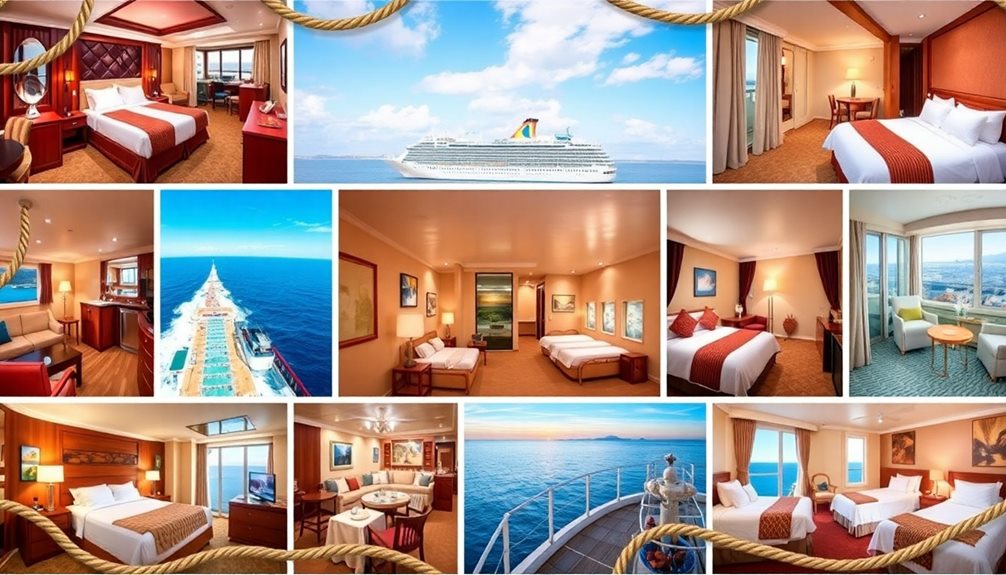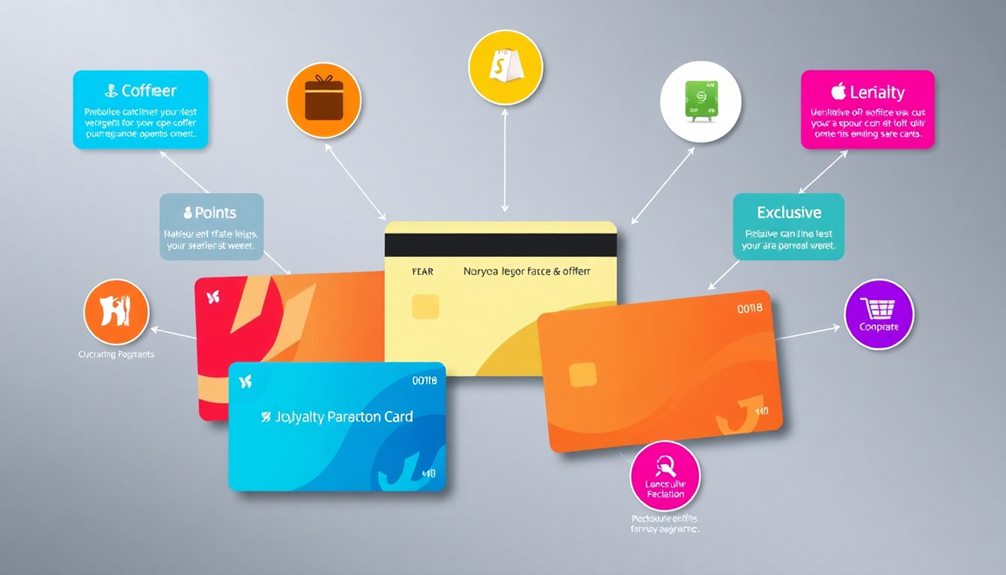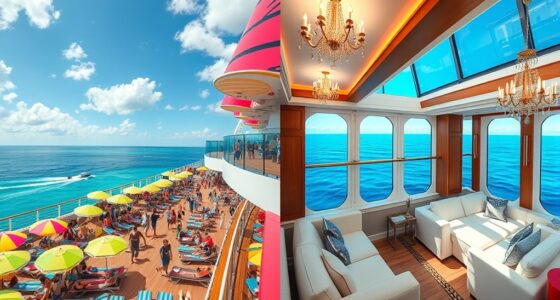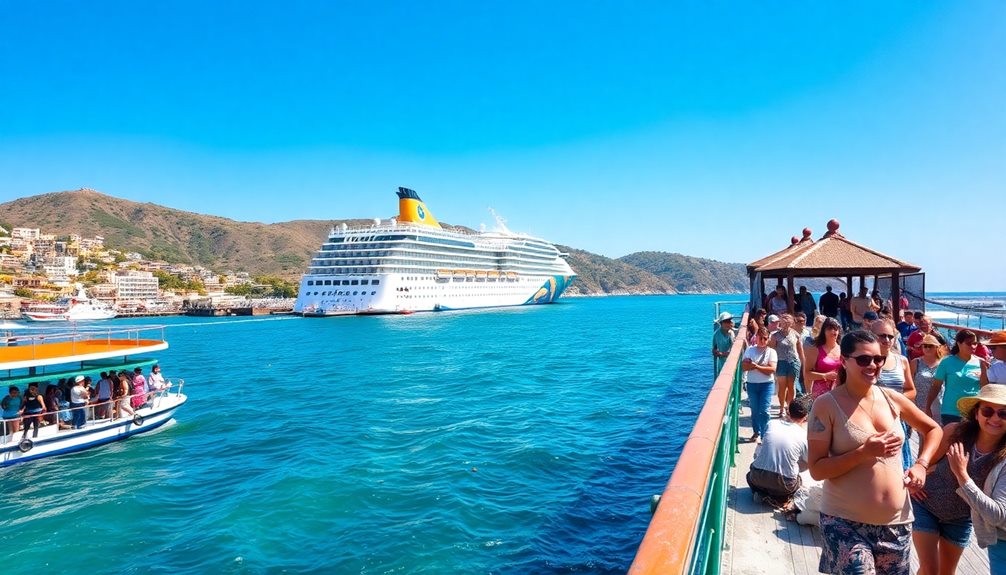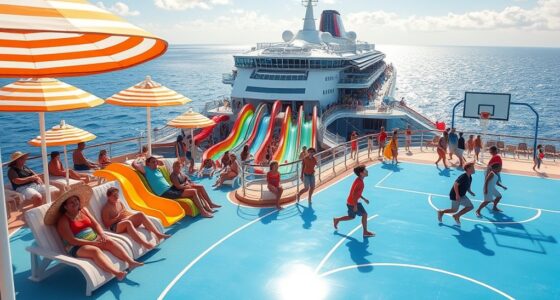When you're planning a cruise, it's important to compare cabin categories to find the perfect fit for your needs. You have four main options: inside, oceanview, balcony, and suites. Inside cabins are budget-friendly but lack natural light. Oceanview cabins provide scenic views and some space, while balcony cabins offer private outdoor spaces that are highly desired. Suites, although pricier, deliver luxury with added amenities and space. Consider your budget and preferences carefully, as each category has its pros and cons. Keep exploring to discover more valuable insights and tips on selecting the right cabin for your trip.
Key Takeaways
- Inside cabins are the most economical choice but lack natural light, making them suitable for budget travelers.
- Oceanview cabins provide scenic views and natural light, typically exceeding 200 sq ft, at a moderate price.
- Balcony cabins offer private outdoor spaces and upgraded amenities, making them highly sought after despite their higher costs.
- Suites deliver luxurious accommodations with personalized service, spacious living areas, and exclusive access, ideal for travelers prioritizing comfort.
- When choosing a cabin, consider factors like budget, desired amenities, and personal preferences to find the best fit.
Overview of Cabin Categories
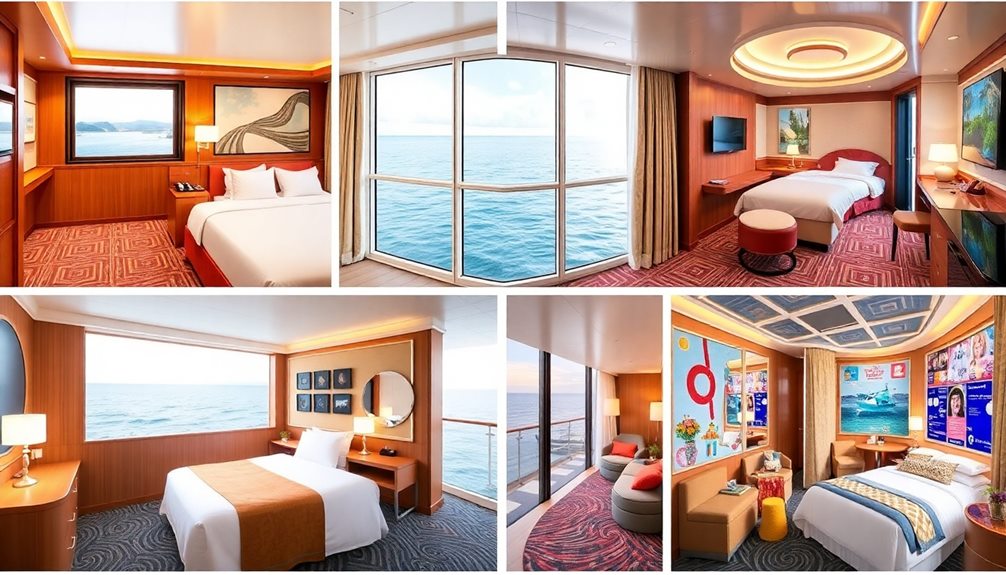
When you're planning a cruise, understanding the different cabin categories can make a big difference in your experience.
Cruise lines typically offer four main cabin categories: Inside, Oceanview, Balcony, and Suites. Each cabin type varies in price, size, and amenities, so knowing what to expect helps you make an informed decision.
Inside cabins are the most economical option, usually lacking windows and ranging from 140 to 200 square feet.
If you want a bit of natural light, consider Oceanview cabins, which feature portholes or larger windows and often exceed 200 square feet. They provide a glimpse of the ocean while still being budget-friendly.
Balcony cabins are highly sought after for their private outdoor space, offering not just fresh air but also additional amenities. These typically range from 170 to over 250 square feet.
If luxury is what you seek, you might explore Suites. They provide the most spacious accommodations, often designed for 4-6 passengers, with exclusive services such as butler service and access to private lounges and dining areas.
Knowing these cabin categories helps you choose the perfect fit for your cruise experience.
Inside Cabin Features
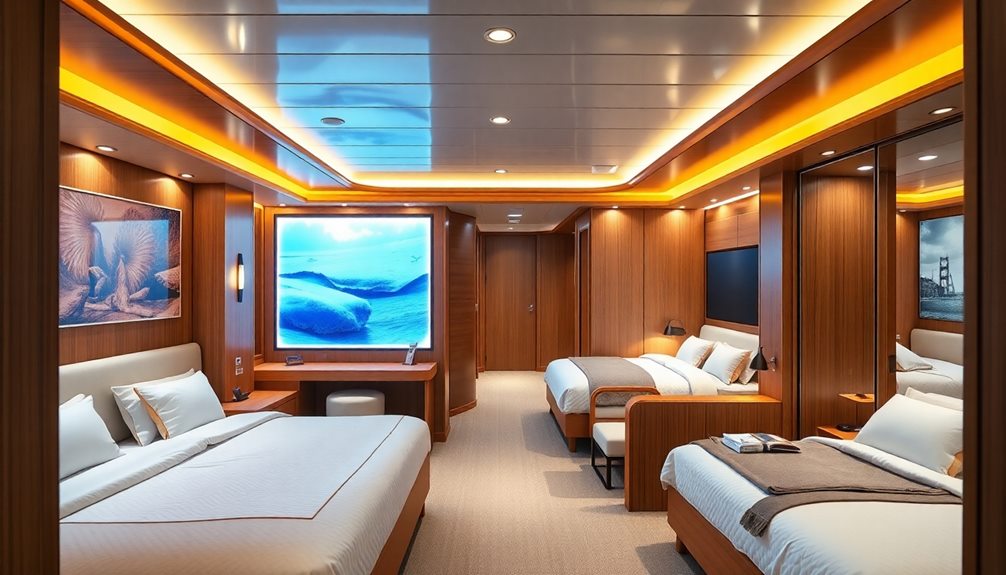
Inside cabins offer a range of features designed to maximize comfort and utility while keeping costs down. These cabins are the most economical choice for travelers and typically range from 140 to 200 square feet. Although they lack windows or balconies, many cruise lines provide various configurations to meet different needs.
When you book a cruise, here's what you can expect from inside cabins:
- Versatile layouts: Options include bunk beds, family interiors, and solo cabins.
- Virtual views: Some ships feature high-definition screens that simulate outside views, enhancing the space's ambiance.
- Accessibility: Accessible inside cabins cater to individuals with disabilities, ensuring everyone can enjoy the cruise experience.
- Cozy yet compact: While cost-effective, these cabins can feel confining for those used to larger spaces.
Keep in mind that the absence of natural light can sometimes lead to a disorienting experience.
However, with the right amenities and thoughtful design, you can enjoy a comfortable and budget-friendly stay at sea.
Oceanview Cabin Insights
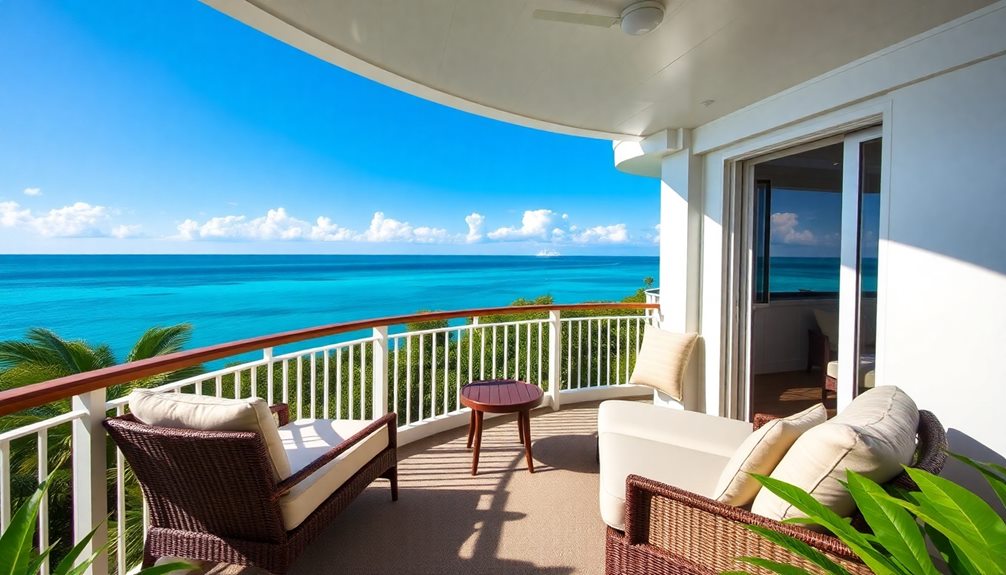
Oceanview cabins invite you to bask in natural light and enjoy scenic views while cruising the open seas. These cabins typically feature either fixed portholes or larger windows, allowing you to soak in the breathtaking scenery outside.
With sizes often exceeding 200 square feet on some ships, oceanview cabins provide ample space compared to standard inside options.
If you're traveling with family, consider connecting oceanview cabins, which offer a convenient way to keep everyone together while enjoying your own private space. However, be mindful of the locations on the ship; some oceanview cabins are positioned on lower decks or directly beneath noisy areas, which can detract from your experience.
Unique configurations in these cabins can enhance comfort and provide additional amenities, making them an appealing choice for travelers seeking a balance of space and scenic enjoyment.
While oceanview cabins are generally priced lower than balcony cabins, you'll still benefit from the natural light and stunning views without the added expense of outdoor space.
Balcony Cabin Highlights

Balcony cabins are the crown jewels of cruise accommodations, providing you with your own slice of outdoor paradise right outside your door.
These cabins are typically the most sought-after option, and it's easy to see why. With private outdoor space, you can enjoy fresh air and stunning ocean views at any time.
Here are some highlights of balcony cabins you'll love:
- Varied Sizes: Ranging from 170 to over 250 square feet, there's plenty of room to relax.
- Upgraded Amenities: Many come with larger bathrooms and enhanced seating areas.
- Better Locations: Often situated on higher decks, you'll enjoy breathtaking views and a more serene atmosphere.
- Exclusive Perks: Enjoy complimentary room service or access to special lounges, enhancing your cruise experience.
Since balcony cabins are in high demand, it's wise to book directly and early to secure your preferred choice.
With a balcony, you'll find your cruise experience is so much better, as you'll have a personal retreat to unwind and savor the ocean's beauty.
Don't miss out on this incredible opportunity!
Suite Advantages
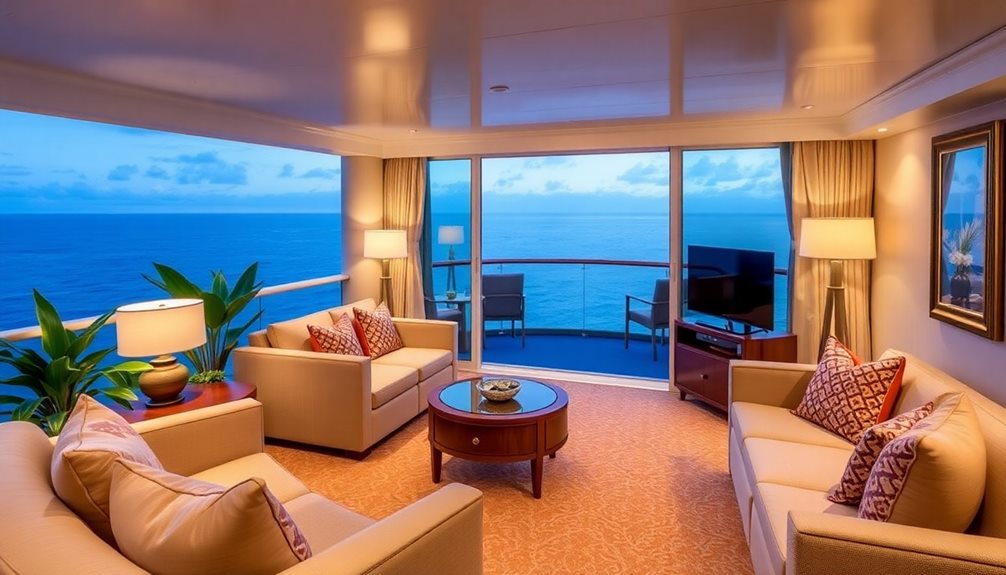
When you choose a suite for your cruise, you're stepping into a world of spacious comfort and luxury that standard cabins simply can't match. Suites typically accommodate 4-6 passengers comfortably, making them perfect for families or groups traveling together. You'll also enjoy luxury amenities, including butler services that cater to your every need, ensuring a personalized experience.
Here's a quick glance at some suite advantages:
| Advantage | Description | Emotion |
|---|---|---|
| More Space | Enjoy larger living areas for socializing. | Freedom |
| Personalized Service | Benefit from dedicated butlers and concierges. | Pampered |
| Exclusive Access | Access to private dining and premium seating. | VIP Experience |
Booking a suite can be more economical compared to reserving multiple smaller cabins. The larger space serves as a common area where you can bond and create lasting memories. Plus, with dedicated check-in areas, you'll experience expedited boarding and debarkation processes. With competitive prices available, indulging in a suite on your next cruise is an opportunity you shouldn't miss!
Pros and Cons of Cabin Types

Choosing the right cabin type for your cruise can greatly impact your experience on board. Each cabin type has its own pros and cons, and understanding these can help you make an informed decision tailored to your needs.
- Inside Cabins: Most economical, perfect for budget travelers, but lack natural light, which may lead to disorientation.
- Oceanview Cabins: Provide natural light and sea views at a moderate price, but you won't have the outdoor space of a balcony.
- Balcony Cabins: Offer private outdoor space and a desirable mid-ship location, enhancing your experience, though they come with a notably higher price tag.
- Suites: Provide the most luxurious experience with extra space and exclusive amenities, yet the cost may be too steep for some travelers.
When considering different cruise lines, weigh the benefits against your budget and preferences.
Each cabin type serves various traveler needs, from those prioritizing cost to those seeking luxury.
Choosing the Right Cabin

Selecting the right cabin can greatly enhance your cruise experience. When choosing your cabin, consider the four main categories: inside, oceanview, balcony, and suites. Each offers distinct amenities and price points tailored to different budgets and preferences.
If you're budget-conscious and plan on spending time outside your room, an inside cabin might be ideal. These cabins are the most economical, ranging from 140-200 square feet.
If you desire natural light and a view, oceanview cabins provide portholes or larger windows, making them a popular choice that fills up quickly.
For those who want a personal outdoor space, balcony cabins are the most sought-after type, ranging from 170 to over 250 square feet. These cabins greatly enhance the cruising experience by allowing you to enjoy the fresh air and scenery from your private balcony.
On the other hand, if luxury is your priority, suites offer the most space and exclusive services like butlers and lounge access, though they come at a higher cost.
Ultimately, selecting the right cabin would depend on your preferences, budget, and how much time you plan to spend in your room.
Tips for Cabin Upgrades
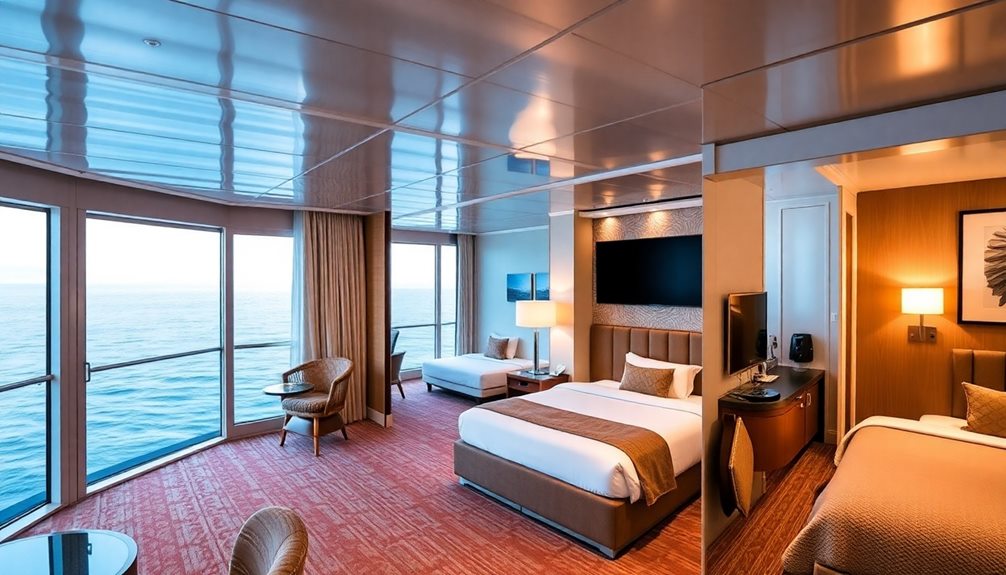
Upgrading your cabin can elevate your cruise experience without breaking the bank. Here are some tips to help you snag those coveted cabin upgrades:
- Use loyalty points: Frequent flyer miles or loyalty points can often be redeemed for cabin upgrades, providing significant savings compared to cash.
- Watch for promotions: Keep an eye out for promotional offers from cruise lines that may include discounted upgrades at the time of booking or check-in.
- Bid for upgrades: Some cruise lines let you bid for upgrades, giving you a chance to secure a higher category cabin at a lower price.
- Ask about last-minute options: Inquire about last-minute upgrades at the port or during boarding. Unsold higher-category cabins might be available, offering you a great deal.
Additionally, consider booking during off-peak seasons. The lower demand can increase your chances of receiving complimentary upgrades.
Resources for Cabin Information
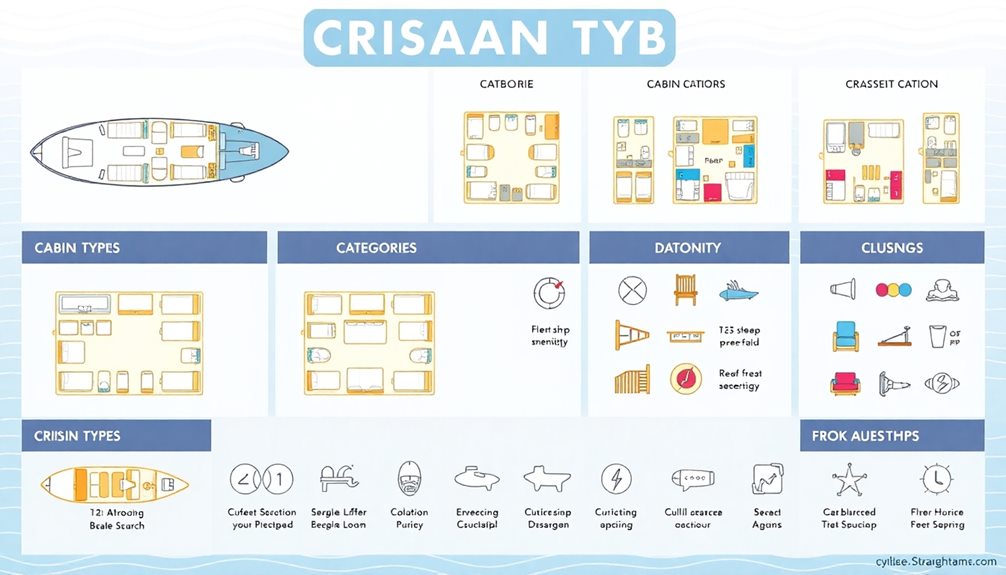
When planning your cruise, deck plans are key for visualizing cabin locations and types.
Travel agent resources can give you detailed insights into the amenities each cabin offers, helping you choose wisely.
Don't forget to check out community forums where fellow cruisers share their experiences and tips on cabin selections.
Deck Plans Overview
Understanding deck plans is essential for making informed choices about your cabin on a cruise. These plans provide a visual representation of cabin locations, helping you navigate the layout and proximity of different cabin categories on the ship.
To make the most of your experience, consider these key points:
- Color-Coded Categories: Differentiate between suite locations, balcony cabins, and interior rooms easily.
- Detailed Information: Access amenities and public spaces listed on cruise lines' websites for better booking decisions.
- Avoid Undesirable Locations: Learn to steer clear of cabins under noisy areas or far from essential amenities.
- Community Resources: Leverage travel agent websites and forums for insights and comparisons of deck plans across various cruise ships.
Community Insights Sharing
Community insights can be a game-changer when choosing the right cabin on your cruise. Engaging in community insights sharing, whether through forums or social media, gives you access to valuable personal experiences from fellow travelers. These insights help you understand specific cabin categories, ensuring you make informed decisions based on real-life feedback.
Travel agent websites are another essential resource, as they often include detailed cabin specifications and amenities. This information allows you to compare different cabin options across various cruise lines effectively. Additionally, color-coded deck plans visually represent cabin placements, making it easier to spot desirable locations and potential upgrades.
Websites like Halfacts can further assist by offering layout comparisons between different suite types, helping you visualize your choices before booking.
Travel Agent Resources
Travel agents frequently provide invaluable resources for cabin information, streamlining your decision-making process. With their expertise, you can navigate the complexities of various cabin categories offered by different cruise lines.
Here are some key resources you can expect from your travel agent:
- Detailed Deck Plans: Access to intricate deck layouts, helping you visualize cabin locations.
- Cabin Comparisons: Thorough comparisons of cabin categories, showcasing variations in size, amenities, and pricing.
- Exclusive Discounts: Information on promotions through affiliate programs that aren't available to the general public.
- Community Feedback: Insights into reviews and feedback from travelers who've stayed in specific cabins.
Engaging with a travel agent not only enhances your understanding of cabin options but also aids in identifying guarantee bookings and potential upgrades.
They guide you through the nuances of cabin selection, ensuring you maximize your cruise experience. With their support, you can confidently choose the perfect cabin tailored to your preferences and needs.
Trust your travel agent to be your resource for an unforgettable cruise adventure!
Conclusion
In the end, choosing the right cabin can make or break your cruise experience. Whether you prefer the cozy feel of an inside cabin or the luxurious space of a suite, each option has its perks. Don't forget to weigh the pros and cons to find what suits your needs best. With a little planning and a keen eye for upgrades, you'll be sailing smoothly into the sunset, enjoying every moment of your getaway.

